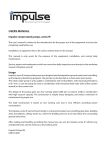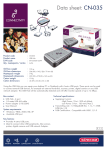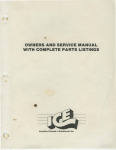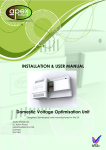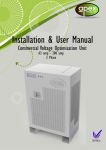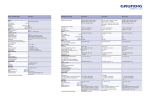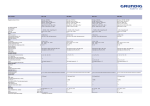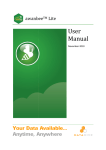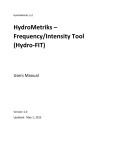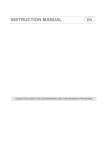Download Practical Guide to Inspection, Testing and Certification of
Transcript
Practical Guide to Inspection, Testing and Certification of Electrical Installations I would like to dedicate this book to all of my grandchildren and thank them for leaving me in peace when asked. Practical Guide to Inspection, Testing and Certification of Electrical Installations Third Edition Christopher Kitcher Third edition published 2013 by Routledge 2 Park Square, Milton Park, Abingdon, Oxon OX14 4RN Simultaneously published in the USA and Canada by Routledge 711 Third Avenue, New York, NY 10017 Routledge is an imprint of the Taylor & Francis Group, an informa business © 2013 Christopher Kitcher The right of Christopher Kitcher to be identified as author of this work has been asserted by him in accordance with sections 77 and 78 of the Copyright, Designs and Patents Act 1988. All rights reserved. No part of this book may be reprinted or reproduced or utilised in any form or by any electronic, mechanical, or other means, now known or hereafter invented, including photocopying and recording, or in any information storage or retrieval system, without permission in writing from the publishers. The publisher and author disclaim any liability, in whole or in part, arising from information contained in this publication. The reader is urged to consult with an appropriate licensed professional prior to taking any action or making any interpretation that is within the realm of a licensed professional practice. Trademark notice: Product or corporate names may be trademarks or registered trademarks, and are used only for identification and explanation without intent to infringe. First edition published by Newnes 2007 Second edition published by Newnes 2008 British Library Cataloguing in Publication Data A catalogue record for this book is available from the British Library Library of Congress Cataloging-in-Publication Data Kitcher, Chris. Practical guide to inspection, testing, and certification of electrical installations / Chris Kitcher. -- 3rd ed. p. cm. 1. Buildings--Electric equipment--Inspection--Handbooks, manuals, etc. I. Title. TK4001.K48 2012 621.319'240288--dc23 2011035997 ISBN 13: 978-0-08-096907-7 (pbk) Contents List of figures and tables Acknowledgements Chapter 1 Chapter 2 Chapter 3 xi xv Introduction 1 Inspection and testing of electrical installations 1 The legal requirements 5 BS 7671 Building Regulation Part P Section 1. Design, installation, inspection and testing Section 2. Extensions, material alterations and material changes of use Section 3. Information about other legislation Compliance with Building Regulations Part P Earthing and bonding to comply with Part P Registered domestic installer Unregistered competent person DIY installer Summary 6 6 8 8 9 10 10 11 11 12 Types of certification required for the inspecting and testing of electrical installations 13 7 Certification required for domestic installers (Part P) Minor electrical installation works certificate Part P domestic electrical installation certificate Periodic inspection, testing and reporting Certification required for the inspecting and testing of installations other than domestic Minor electrical installation works certificate Electrical installation certificate 13 13 13 14 Initial verification inspection 21 Initial verification testing Sequence of tests Periodic inspection Extent and limitations Visual inspection 23 23 23 24 25 15 15 15 vi Contents What are we looking for during a periodic inspection? Three phase circuits/systems Chapter 4 Chapter 5 35 39 Periodic testing 41 Voltage drop in conductors Testing of electrical installations Safe isolation Safe isolation procedure Testing of protective bonding conductors Main protective bonding Continuity of protective supplementary bonding conductors Determining if a metal part is extraneous or just a piece of metal Continuity of circuit protective conductors Method 1 Method 2 Ring final circuit test Broken conductor in a ring circuit Interconnections Polarity Insulation resistance test Low insulation resistance Testing the whole installation Testing of individual circuits Surge protection Insulation resistance testing of a 3 phase installation Polarity test Polarity test on a radial circuit such as a cooker or immersion heater circuit Polarity test on a lighting circuit Live polarity 44 46 46 49 53 53 Earth electrode testing Measurement using an earth electrode tester Performing the test Testing with an earth loop resistance tester Earth fault path for a TT system Earth fault path for a TN-S system Earth fault path for a TN-C-S system Performing a Ze test Circuit earth fault loop impedance Zs Verification of Zs values Method using tables from GN3 or the On-site Guide 61 66 66 67 69 70 71 72 72 80 81 82 88 89 91 96 96 97 103 105 105 105 109 112 112 112 112 114 119 123 Contents Direct measurement A circuit incorporating a socket outlet on a ring or a radial Performing the test on a radial circuit other than a socket outlet Earth loop impedance using a high current loop test instrument without tripping an RCD Prospective fault current test (Ipf) Enquiry Calculation Measurement Three wire text Functional testing Residual current device Types of RCD RCDs and supply systems Testing of RCDs Voltage operated (ELCBs) BS 4293 RCDs BS EN 610081 BS 4293 type S BS EN 61008 type S BS 7288 RCD protected socket BS EN 61009 RCBOs Chapter 6 Completion of test certificates Minor electrical installation works certificate Part 1 Description of minor works Part 2 Details of the installation Part 3 Essential tests Part 4 Declaration Electrical installation certificate Information required Next inspection Supply characteristics and earthing arrangements Nature of supply parameters Frequency Prospective fault current (Ipf) External earth loop impedance (Ze) Supply protective device Particulars of the installation referred to in the certificate Main protective conductors Main switch or circuit breaker Comments on the existing installation 123 124 124 131 133 133 134 134 136 138 138 139 141 141 141 142 147 147 148 148 148 151 151 151 153 153 154 154 154 159 159 160 160 160 160 160 160 161 161 162 vii viii Contents Chapter 7 Schedules Schedule of test results Information required Test results Schedule of inspections Description of items to be checked Basic protection Fault protection Prevention of mutual detrimental influence Identification Cables and conductors General Electrical installation condition report Completing the form Summary on the condition of the installation Recommendations Declaration Schedules Supply characteristics and earthing arrangements. Particulars of the installation referred to in the certificate Main protective conductors Main switch/switch fuse/circuit breaker Observations Condition report inspection schedule 162 162 163 164 165 165 166 166 168 168 169 170 171 175 176 176 177 177 Correct selection of protective devices 185 Why are they installed? What type of device is it? Is it a fuse or circuit breaker? Is the device being used for protection against indirect contact? What type of circuit is the device protecting, is it supplying fixed equipment only, or could it supply hand held equipment? If it is a circuit breaker is it the correct type? Will the device be able to safely interrupt the prospective fault current which could flow in the event of a fault? Is the device correctly coordinated with the load and the cable? Additional information regarding circuit breakers Overload current Maximum earth fault loop impedance values (Zs) for circuit breakers 177 179 179 180 180 181 185 186 187 187 187 188 188 188 188 188 Contents Calculation of the maximum Zs of circuit breakers Comparing maximum Zs and measured Zs Testing transformers Step up or down double wound transformer Isolation transformer Separated extra low voltage transformers (SELV and PELV) Testing a 3 phase motor Chapter 8 Test equipment Instruments required Low resistance ohm meter Insulation resistance tester Earth fault loop impedance tester Prospective short circuit current test instrument Earth electrode resistance tester Residual current device tester Phase rotation Thermographic equipment Calibration of test instruments Volt stick Chapter 9 189 190 191 191 192 192 192 195 195 195 196 196 196 196 197 197 197 197 199 Electric shock 201 Ingress protection 203 Chapter 10 Testing photovoltaic systems Testing and commissioning Visual inspection Testing the d.c. side of the installation Insulation resistance test Testing the a.c. side of the installation 205 205 205 208 216 219 Chapter 11 Exercises and questions Chapter 12 Answers 223 239 Glossary Index 263 269 ix List of figures and tables Figures Figure 1.1 Figure 1.2 Figure 2.1 Figure 2.2 Figure 2.3 Figure 2.4 Figure 3.1 Figure 3.2 Figure 4.1 Figure 4.2 Figure 4.3 Figure 4.4 Figure 4.5 Figure 4.6 Figure 4.7a Figure 4.7b Figure 4.8 Figure 4.9a Figure 4.9b Figure 4.9c Figure 4.10 Figure 4.11 Figure 4.12 Figure 4.13 Figure 4.14 Figure 4.15 Figure 4.16 Figure 4.17 Figure 4.18 Figure 4.19 Figure 4.20 Figure 4.21 Figure 4.22 Figure 4.23 Figure 4.24 Figure 4.25 Wind up insulation resistance tester Earth fault loop impedance tester Minor electrical installation work certificate Electrical installation certificate Schedule of test results Schedule of inspections Electrical installation condition report Condition report schedule of inspection Approved voltage indicator and test lamp Warning notices Locking devices Proving unit R1 + R2 box Test line to neutral Test line to earth Neutral to earth Locked off Test line to neutral Line to earth Neutral to earth Retest device Double check Isolate the supply Bonding disconnected Low resistance ohm meter Lead connected Second lead connected Resistance value Reconnect bonding Incorrect! Correct! Lead touching tap Lead on unpainted part of radiator Fitting bonded across Current flow through pipe Cables joined 1 2 16 17 19 20 26 28 47 47 48 48 49 49 50 50 51 52 52 52 53 55 55 56 57 57 58 58 59 60 60 64 64 65 65 67 xii List of figures and tables Figure 4.26 Figure 4.27 Figure 4.28 Figure 4.29 Figure 4.30 Figure 4.31 Figure 4.32 Figure 4.33 Figure 4.34 Figure 4.35 Figure 4.36 Figure 4.37 Figure 4.38 Figure 4.39 Figure 4.40 Figure 4.41 Figure 4.42 Figure 4.43 Figure 4.44 Figure 4.45 Figure 4.46 Figure 4.47 Figure 4.48 Figure 4.49 Figure 4.50 Figure 4.51a Figure 4.51b Figure 4.51c Figure 4.52 Figure 4.53 Figure 4.54 Figure 4.55 Figure 4.56 Figure 4.57 Figure 4.58 Figure 4.59 Figure 4.60 Figure 4.61 Figure 4.62 Figure 4.63 Figure 4.64 Figure 4.65 Figure 4.66 Figure 4.67 Figure 5.1 Figure 5.2 Probes on line and earth Lead connected to earthing terminal Lead touching earthed metal Ring circuit Broken conductor Interconnection Set to ohms Test each end of the line conductor Test each end of the neutral conductor Test each end of the CPC Cross connect live ends Test line to neutral Cross connect line to earth Test line to earth at each socket Cross connect live conductors Conductors in series Conductors in parallel Leads apart Leads together Instruments set Test between live conductors Join live conductors and test to earth Test between live conductors Live conductors tested to earth Test the set Test L2 to L3 Test L1 to L3 Test L1 to L2 Link L1, L2 and L3 Test line to earth Line and CPC connected Test between line and earth R1 + R2 High reading Line linked to earth terminal Test between earth and switched line Low reading High reading Line and earth terminal linked Test at switch Low resistance measure High reading Live supply Live supply No reading Earth electrode tester Electrodes in the ground 68 69 70 71 72 73 74 74 75 75 76 76 77 78 79 80 80 83 83 85 86 87 90 90 91 92 93 93 94 94 97 97 98 98 99 99 100 101 101 102 102 103 104 104 106 107 List of figures and tables Figure 5.3 Figure 5.4 Figure 5.5 Figure 5.6 Figure 5.7 Figure 5.8 Figure 5.9 Figure 5.10 Figure 5.11 Figure 5.12 Figure 5.13 Figure 5.14 Figure 5.15 Figure 5.16 Figure 5.17 Figure 5.18 Figure 5.19 Figure 5.20 Figure 5.21 Figure 5.22 Figure 5.23 Figure 5.24 Figure 5.25 Figure 5.26 Figure 5.27 Figure 5.28 Figure 5.29 Figure 5.30 Figure 5.31 Figure 5.32 Figure 5.33 Figure 5.34 Figure 5.35 Figure 5.36 Figure 5.37 Figure 5.38 Figure 5.39 Figure 5.40 Figure 5.41 Figure 5.42 Figure 5.43 Figure 5.44 Figure 5.45 Figure 5.46 Figure 6.1 Figure 6.2 Tester connected TT service head TT fault path TN-S service head TN-S fault path TN-C-S service head TN-C-S fault path Isolated Disconnected earthing conductor Test instrument Line to earth Line to neutral and earth Certificate R1 + R2 path Measured value Two lead connection Three lead connection Two lead connection Three lead connection Line and earth linked Incoming supply to outgoing line Instrument set Test between incoming line and neutral Measured value Leads connected BS EN 60898 Voltage operated RCD BS 4293 BS 4293 type S Single phase Three phase RCD socket outlet BS EN 61009-1 BS EN 61008-1 type S Set at times half No trip No trip Test at times one Test at 180° Set at times five Test at zero degrees Test at 180° Manual test Test label Minor works certificate Electrical installation certificate 110 113 113 114 114 115 115 116 117 117 118 118 119 119 124 125 126 127 127 132 132 135 135 136 137 138 139 139 140 140 140 140 141 141 143 143 143 144 144 145 145 146 146 147 152 155 xiii xiv List of figures and tables Figure 6.3 Figure 6.4 Figure 6.5 Figure 6.6 Figure 8.1 Figure 8.2 Figure 10.1 Figure 10.2 Figure 10.3 Figure 10.4 Figure 10.5 Figure 10.6 Figure 10.7 Figure 10.8 Figure 10.9 Figure 10.10 Figure 10.11 Figure 10.12 Figure 10.13 Figure 10.14 Schedule of test results Schedule of inspections Electrical installation condition report Condition report inspection schedule Test box Calibration register Transformer inverter Inverter without transformer D.C. identification Dual isolation label Commissioning report Voltage measurement Irradiance meter D.C. clamp meter D.C. leads joined Current measurement using clamp meter Current measurement using a multimeter D.C. isolated D.C. cables linked Insulation test 157 158 172 182 198 199 206 206 207 208 209 211 214 214 216 217 218 219 220 220 Tables Table 4.1 Table 4.2 Table 4.3 Table 5.1 Table 5.2 Table 5.3 Table 7.1 Table 9.1 Table 9.2 Table 10.1 Table 11.1 Table 11.2 Table 11.3 Table 11.4 Recommended tests for further testing Maximum length of copper protective bonding conductor Minimum acceptable resistance values Electrode resistance values Ambient temperature multipliers Examples of rated short circuit capacities for devices Circuit breaker application Table of IP ratings Third letter Panel data sheet Circuit details Circuit details Ring circuit detail Zs values 43 54 81 111 121 138 190 204 204 211 225 226 229 231 Acknowledgements Central Sussex College for the use of their workshop facilities Simon Wood of Megger UK for help beyond the call of duty Dave Chewter for always being ready to help with anything Introduction Inspecting and testing of electrical installations We all use electricity every day and most of us just take it for granted that it is safe to use. Of course, for the majority of time it is. This is not usually down to luck, although when I think about some of the installations which I have seen over the years, I am well aware that on some occasions luck must have been around in abundance. Over the years the way we deal with electrical installations has changed dramatically, this is of course down to education and experience. Apart from the use of modern materials and methods of installation we also have improved legislation in place which should ensure that all installations are inspected regularly. When I first stated full-time work back in the early 1960s, there were massive house building projects being carried out all over the country, but testing and certification of new installations was virtually unheard of. When we had completed a new domestic installation, the supply authority were really only interested in getting a signature from the person who was going to be expected to pay the electricity bill each quarter. We used to do an insulation resistance test on the meter tails and the person who installed the meter usually did the same before connection, but that was all. The insulation resistance tester was not anywhere near as sophisticated as a modern one, we used to have to wind the handle of the instrument as it was a mini generator (Figure 1.1). I remember clearly that if for some reason we had a fault due to a nail being driven through a cable, or some other fault which resulted in a bad reading, we would just remove the fuse wire from the rewirable fuses, or disconnect the neutral of the circuit concerned before the person arrived to install the meter. That way we could be sure that the installation would be connected and that we would have an electrical supply. It is usually easier to trace a fault if the system is live, particularly in the winter, as it is much easier to find a fault in a warm house with light than a cold house in the dark. As far as earth fault loop impedance was concerned the only time we measured that was when a survey was being carried out, and again Figure 1.1 Wind up insulation resistance tester 2 Introduction Figure 1.2 Earth fault loop impedance tester the instrument was entirely different to the equipment used today (Figure 1.2). All new houses had a copper or iron water main, as did most old ones. As you can imagine, the surface area of the metal from the water mains in contact with the soil was huge. This resulted in very low earth fault loop resistance readings. This is because the resistance of soil is usually very low as there is such a lot of it. As the years have passed more and more electrical equipment is being installed into buildings; it is also becoming more and more sophisticated of course. Health and safety, along with insurance, has also had a hand in making it important that in the event of a fault somebody can be held responsible. Usually this will be the person signing the document to say that the installation is compliant with the current edition of the wiring regulations (BS 7671). For this reason it is very important that we take the installation of electrical wiring along with inspection, testing and certification very seriously. It is important that we not only know how to install all of our new fixed wiring correctly, but that we know how to verify and document it as well. Not only that! We should also be able to inspect an existing installation and, with the help of some testing where required, we should be able to verify that it is fit for continued safe use. Where damage or non-conformities are found we must be able to identify them and make sound, professional recommendations about the installation. Introduction We must also be able to relay this information to our clients in a professional, non-technical manner. Many of us will remember how difficult it was to understand the terms used in the electrical industry when we first started out. Your client will need you to identify the technical detail, record it and then relay it to them in words which they can understand, of course before we can do that we need to understand it ourselves. Hopefully what follows in this book will be of help. Video footage and multiple choice questions are also available to help you with this subject. Visit www.routledge.com/cw/kitcher to access this material. 3 CH A P TE R The legal requirements Apart from the obvious safety reasons, we also have to concern ourselves with the legal requirements for electrical installations. The main statutory documents which we need to comply with are: ● ● ● The Health and Safety at Work Act 1974 (HASWA) The Electricity at Work Regulations 1989 (EAWR) The Electrical Safety, Quality and Continuity Regulations 2002 (ESQCR). The HASWA 1974 is in place to cover all aspects of safety at work and can be viewed as the statutory document under which the other statutory documents which involve health and safety sit. The EAWR 1989 are specific to electrical installations used in the work place, although it is sensible for us to refer to them for all installations as this will ensure an electrically safe environment. Non-compliance with statutory regulations will be seen as a criminal offence, and for that reason non-compliance could result in a very large fine or even in some serious cases imprisonment, particularly where the non-compliance has resulted in an accident. The ESQCR are intended more for electrical supplies but do have some effect on the daily activities of electricians, particularly with regards to the positioning of consumer’s units and areas where TNC systems are used. As an example, where an area is known to be susceptible to flooding all of the supply equipment and consumer’s units need to be sited above the expected flood level. These statutory regulations not only apply to new installations, they also apply to existing installations which have been in use for a very long time. There is no age limit on electrical installations: the requirement is that they are maintained in a safe condition and that they remain fit for use. Practical Guide to Inspection, Testing and Certification of Electrical Installations. 978-0-08-096907-7 Copyright © 2013 Christopher Kitcher. Published by Taylor & Francis. All rights reserved. 1 6 1 Practical Guide to Inspection, Testing & Certification of Electrical Installations BS 7671 The most satisfactory way of ensuring conformance with statutory regulations is to follow the requirements of the relevant British Standard. The British Standard relating to an electrical installation is known as BS 7671. Within this set of standards Regulation 610.1 states ‘every installation shall, during erection and on completion before being put into service be inspected and tested to verify, so far as reasonably practicable, that the requirements of the regulations have been met’. This regulation of course applies not only to new installations, it also applies to additions and alterations to existing installations. The inspection and testing of new work is known as initial verification. As the regulation suggests, this initial verification commences at the same time as the installation work continues and carries on through the duration of the job. The end result will be the issue of an electrical installation certificate, along with the required schedule of test results and a schedule of inspections, providing of course the work carried out fully meets the requirement of BS 7671. As we have seen previously the EAWR 1989 is not only for new installations, if anything it is more relevant to existing installations. BS 7671 Regulation 621.1 states that ‘where required, periodic inspection and testing of every installation shall be carried out in accordance with Regulations 621.2 to 5 in order to determine, so far as is reasonably practicable, whether the installation is in a satisfactory condition for continued service’. Although BS 7671 is a non-statutory document it has been referred to extensively in the Health and Safety Executive over a long period of time. Regulation 114 also clearly states that although BS 7671 is nonstatutory it may be used in a court of law to claim compliance with a statutory requirement. It has been my policy over the years to explain as clearly as possible to my students that although it is non-statutory, we all do ourselves a big favour by pretending that it is statutory; this will ensure that we do the best job possible and that all safety requirements are met. Building Regulation Part P The HASWA and EAWR both have the word work in them and of course that reflects that they are intended for use in the work place. However electricity is, or can be, a dangerous commodity wherever it is used. It could also be argued that a domestic installation is a The legal requirementss place of work while the electrical installation is being carried out. This means that the HASWA and EAWR are still relevant. Domestic installations have been the subject of much discussion over the years, mainly due to the upsurge in DIY. We all know that it is reasonably easy to get something working, making sure it is safe is often far more difficult. To try and get some kind of control over this, the Building Regulation Part P was introduced and came into effect on 1 January 2005; it was then amended on 5 April 2006. The purpose of this document is to ensure electrical safety in domestic electrical installations. Section 1. Design, installation, inspection and testing This section of Part P is broken down into sub-sections. General This states that electrical work must comply with the Electricity at Work Regulations 1989 and that any installation or alteration to the main supply must be agreed with the electricity distributor. Design and installation This tells us that the work should comply with BS 7671 Electrical Wiring Regulations. Protection against flooding The distributor must install the supply cut out in a safe place and take into account the risk of flooding. Compliance with the Electrical Safety, Quality and Continuity Regulations 2002 is required. Accessibility Part M of the building regulations must be complied with. Inspection and testing before putting into service This area is covered in detail throughout this book, it reminds us that the installation must be inspected and tested to verify that it is safe to put into service. BS 7671 Installation certificates This tells us that compliance with Part P can be demonstrated by the issue of the correct electrical installation certificate. It also shows what the certificate should cover. This is addressed later in this book. 1 7 8 1 Practical Guide to Inspection, Testing & Certification of Electrical Installations Building regulation compliance certificates or notices for notifiable work This tells us that the completion certificates issued by the local authorities, etc. are not the same as the certificates that comply with BS 7671. The completion certificates do not only cover Part P, but also shows compliance with all building regulations associated with the work which has been carried out. Certification of notifiable work This is covered in detail throughout this book. Inspection and testing of non-notifiable work This tells us that, even if the work is non-notifiable, it must be carried out to comply with BS 7671 and that certificates should be completed for the work. Provision of information Information should be provided for the installation to assist with the correct operation and maintenance. This information would comprise certification, labels, instruction and plans. Section 2. Extensions, material alterations and material changes of use This section is covered throughout this book. It basically tells us that certification is required, and that before any additions or alterations are made to an installation, an assessment of the existing installation should be made, to ensure that it is safe to add to. Section 3. Information about other legislation This covers the Electricity at Work Regulations 1989; Electrical Safety, Quality and Continuity Regulations 2002; and functionality requirements. The construction design and management regulations also state that adequate electrical inspection and tests are carried out on all new installations; those with electrical design information must form a user’s manual, which can be used to provide an up-to-date working record of the installation. Due to the introduction of Part P even people who are not in the electrical industry are becoming more and more aware that electrical installations need to be safe. Insurance companies and mortgage The legal requirementss lenders are now frequently asking for certification as part of the house buying and selling process. The owners and occupiers of industrial and commercial properties are aware that the EAWR 1989 demand that they maintain a safe environment for people to work in, while most licensing authorities and local authorities are asking for electrical certification for most of the work with which they become involved. All of these regulations are under the umbrella of the Health and Safety at Work Act 1974. This clearly puts the legal responsibility of health and safety on all persons concerned. Compliance with Building Regulations Part P Compliance with building regulations is a legal requirement and electrical work carried out in the domestic sector is now included in the building regulations; it is a criminal offence not to comply with the building regulations. At the time of writing, there is no legal requirement to notify any work carried out in commercial or industrial buildings, although it should still be certificated for safety and record-keeping purposes. Approved Document Part P requires that most electrical work carried out in domestic premises is notified to the local authority building control. There are a few exceptions but the work must comply with BS 7671 Wiring Regulations. The exceptions are as follows: ● ● Minor works carried out in areas that are not classed as special locations and therefore do not need notifying but would still need certifying: – addition of socket outlets and fused spurs to an existing radial or ring circuit – addition of a lighting point to an existing circuit – installing or upgrading main or supplementary bonding. Minor works carried out in the special locations as listed below – or in kitchens (BS 7671 does not recognize a kitchen as a special location. Part P does): – kitchens – locations containing bath tubs or shower basins – hot air saunas – electric floor or ceiling heating – garden lighting (if fixed to a dwelling wall it is not deemed to come into the special location category) – solar photovoltaic power supply systems. 1 9 10 1 Practical Guide to Inspection, Testing & Certification of Electrical Installations ● ● ● ● The work which could be carried out in these locations without notification but should still be certificated would be: Replacement of a single circuit which has been damaged – providing that the circuit follows the same route – the cable used has the same current carrying capacity as the cable being replaced – circuit protective measures are not affected. Replacing accessories such as socket outlets, switches and ceiling roses Re-fixing or replacing of enclosures and components. All other work carried out in any areas of a domestic installation must be certificated and notified to the local authority building control, this can be carried out by various methods. Earthing and bonding to comply with Part P If a minor electrical installation works certificate is necessary, there is no requirement to upgrade the existing earthing and bonding arrangements within an installation. Where the earthing and bonding do not comply with the latest edition of BS 7671, it should be recorded on the minor electrical installation works certificate and brought to the responsible person’s or occupier’s attention. If the work being carried out requires an electrical installation certificate to be completed, then the earthing arrangements must be upgraded to comply with the current edition of BS 7671. Where the work is in a bathroom or any other areas which may require protective supplementary bonding, then this must also be brought up to the current standard. There is no requirement to upgrade supplementary bonding in an area where work is not to be carried out. There is also no requirement under Part P to certificate the upgrading of any earthing and bonding that has been carried out to an existing installation. Registered domestic installer To become a registered domestic installer, it is necessary to become a member of one of the certification bodies which operate a domestic installer’s scheme. This would require the person carrying out the work to prove competence in the type of work which is being carried out, and the ability to inspect, test and certificate the work which he/she has carried out. Competence is usually assessed by a site visit from an inspector employed by the chosen scheme provider. The legal requirementss When the scheme was first introduced there were three types of registration: A was for installers who could carry out all types of domestic wiring, B for installers who only needed to install single circuits in relation to the type of work which they were doing. This could have possibly applied to a kitchen installer or a bathroom fitter. Level C was for alterations and minor repairs only. This has now changed and there is now one level of registration only and that is full scope which allows anything from a change of switch to a complete rewire or new installation If the electrician is registered as a domestic installer, he or she must complete the correct certification and notify the scheme provider, with whom they are registered, of the work which has been carried out. This must be done within 30 days. The scheme provider will both notify the local authority and the customer of the correct certification being given. An annual fee is usually required by the scheme provider, while a small fee is also payable for each job registered. Unregistered competent person If the work is carried out by a non-registered competent person who is capable of completing the correct certification, the local authority will need to be contacted before commencement of the work, and the work will be carried out under a building notice. This will involve a fee being paid to the local authority and a visit or visits being made by a building inspector to inspect the work being carried out to ensure that it meets the required standard (the cost of this will usually be far higher than that charged per notification by a scheme provider to a registered installer). On satisfactory completion, and after the issue of the correct certification by the competent person, the building inspector will issue a completion certificate. The issue of a completion certificate by the local authority does not remove the responsibility for the work including guarantees from the nonregistered competent person; the required certification must still be completed by the person who carried out or who is responsible for the work. DIY installer In cases where the work is carried out by a person who could not be deemed qualified (i.e. a DIY enthusiast), building control must be informed prior to work commencing, and on completion of the work to the building control officer’s satisfaction, an inspection and test certificate must be issued. As a DIY installer would be unlikely to have the knowledge, experience or correct test equipment required 1 11 12 1 Practical Guide to Inspection, Testing & Certification of Electrical Installations to carry out the inspection, tests or completion of the certification, the services of a competent person would be required. The qualified person would in effect take responsibility for the new/altered work. For that reason, the qualified person would need to see the work at various stages of the installation to verify that the work and materials used comply with the required standards of the BS 7671 Wiring Regulations. Summary Currently, there is no requirement for any person carrying out electrical work in a domestic environment to be qualified in any way. The condition is that they must be competent; in other words, they must be in possession of the appropriate technical knowledge or experience to enable them to carry out the work safely. Many organizations provide what are known as Part P courses; however, it is not necessary to attend one of these in order to register as a domestic installer. While it may well be beneficial to an electrician who is a bit rusty to attend a refresher course just to ensure that they are aware of the requirements of Part P, it is not possible to become an electrician in 5 days! You will even see advertised courses with duration of from 15 to 30 days, this is really just selling a dream, at the end of the period you will have spent a lot of hard earned cash and collected a lot of certificates. The one thing which you will not have is experience and that is the most important tool which you could possibly have in your box. The building control authorities must be informed of any electrical work that is to be carried out on a domestic electrical installation other than very minor work, although even this work must be certificated. Building control can be informed (before commencing work) by the use of a building notice, and this will involve a fee. If your work involves a lot of domestic electrical work, then by far the best route would be to join one of the certification bodies. This would allow you to self-certificate your own work. When you join one of these organizations, you must be able to show that your work is up to a satisfactory standard and that you can complete the correct paperwork (test certificates). Whichever organization you choose to join, they will give you the correct advice on which training you require. A qualification is fine, but being able to carry out electrical work safely is far better: for that reason high quality training is very important.





























